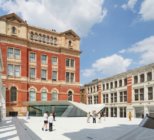The think piece was funded by the National Museum Directors Council (NMDC) as a reflection of its members’, – national museums and major regional museums – ongoing concerns about the future sustainability of civic museums.
Authored by Peter Latchford of consultancy firm, Black Radley Ltd, the report examines the particular qualities, value and importance of civic museums as well as identifying the current challenges they face. The report also explores what they should do to thrive and become more relevant and resilient in the future.
Latchford says that to survive, civic museums ‘must see themselves as part of the wider ecology that surrounds them, building a sense of place, rather than caring for collections in splendid isolation’.
ECMN was established in 2015 to bring together senior museum professionals from organisations with similar backgrounds and governance structures to develop a strategic response to long-term public funding issues. In 2016 the Arts Council awarded £30,000 to Birmingham Museums Trust to initiate the network. It now represents more than 40 museum organisations, that meet three times a year, and the paper is the first public outcome of the Network.
“Many of our civic museums are at a crossroads. Deleterious funding cuts since 2010 have weakened their viability,” said Tony Butler, ECMN member and Director of Derby Museums Trust. “This report explores how our regional museums can be relevant and resilient in an ever changing social and political environment. The gauntlet is thrown down to us all – do we avert risk, retreating back to a perceived core purpose of preservation and education, or do we accept the challenge, thinking anew about our innate qualities and how we might be more useful in the public realm?”
The report argues that:
Civic museums face a funding crisis which is more stark than the one facing museums in general. English Civic Museums Network members typically have 80% of income coming from grants, with 75% coming from local authority funds. The average reduction of this funding was 30% over the last five years. Many have faced significantly greater reductions.
Civic museums have found it hard to respond resiliently to these challenges: constrained as they are by local authorities which rarely offer the freedom of governance to develop the more agile, entrepreneurial models that will be necessary for survival. While local authorities need to free up museums and offer more options, museums themselves must change, including looking again at existing models of staffing as well as widening skillsets.
The report also challenges existing collection policies. Civic museums typically have eclectic collections, from social history to geology, from fine art to archaeology. Caring for these – and often for the historic buildings in which they are displayed – can be all consuming. This model may have worked in the 19th century, but today museums exist in a society which is flooded with information and new experiences. Collections must therefore act as a building block towards telling relevant stories and creating a sense of place, rather than being an end in themselves.
Museums also need to ask hard questions about existing collections practice: is it always wrong to sell some collections items for financial gain to reinvest in the sustainability of the museum if they are not contributing to the museum’s central aims? What new objects should be acquired in our product-heavy, short-cycle-time world where there are so many things that could be collected?
The think piece argues that a new generation of philanthropists is needed, coming from a new appeal to the 55% of the public who define themselves as middle class. This is only likely to be effective if museum buildings and collections generate a grounded sense of place and community.
Civic museums exist in a wider local government and community ecology that is also running into trouble. We live in times characterised by increased wealth inequality and unhappiness, with people often feeling isolated. People may feel little agency in local politics and government seems remote. Health services look unaffordable while concentrating on cure rather than prevention. However, we know that strong social networks keep people well, and that public services need to move to a more inclusive model.
There is a growing sense that society needs a ‘new enlightenment’ – civic museums are well placed to deliver this, offering the health, wellbeing and happiness benefits that flow from a connected community with a shared sense of place. However, both museums themselves and local authorities need a radical rethink to renew these civic spaces.
ECMN member and NMDC Vice-Chair Iain Watson, Director of Tyne and Wear Archives and Museums, said: “Museums are significant civic institutions, and they can also play an increasingly important role in civil society. Peter Latchford’s report provides challenges to museums and their funders. It highlights some uncomfortable truths and suggests how we can adapt to meet the changing needs of society.”
The Think Piece is available to download from this NMDC website link: The Future of Civic Museums: A Think Piece.







